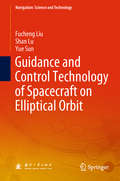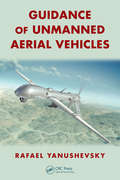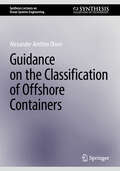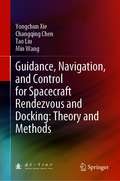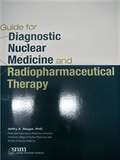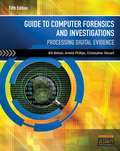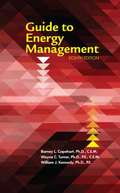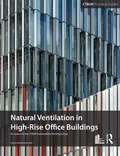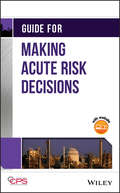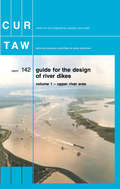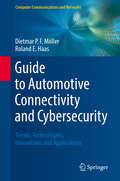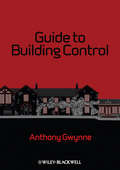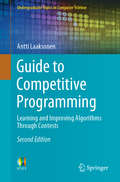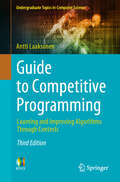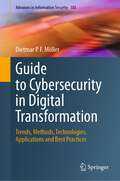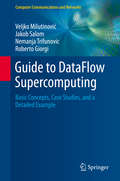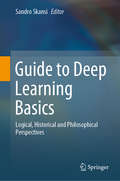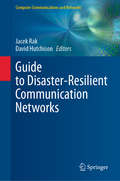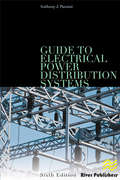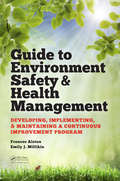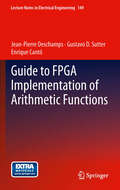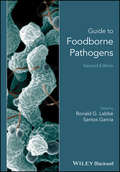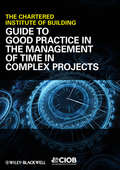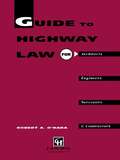- Table View
- List View
Guidance and Control Technology of Spacecraft on Elliptical Orbit (Navigation: Science and Technology)
by Fucheng Liu Shan Lu Yue SunThis book introduces readers to the navigation, guidance and control technologies involved in single-spacecraft, double-spacecraft, and multiple-spacecraft tasks in elliptical orbits. It comprehensively covers the key technologies of guidance, navigation and control (GNC) system design for spacecraft in elliptical orbits, including the orbit design, formation configuration design and maintenance, autonomous navigation technology and relative navigation technology, as well as autonomous rendezvous technology. The methods that this book introduces are very close to actual practical engineering applications and presented in an accessible style. The book can serve as reference teaching material for senior undergraduates and postgraduates with space navigation related majors, while also providing essential information and guidance for research personnel and engineering technical personnel engaged in the development of GNC systems for spacecraft.
Guidance of Unmanned Aerial Vehicles
by Rafael YanushevskyWritten by an expert with more than 30 years of experience, Guidance of Unmanned Aerial Vehicles contains new analytical results, taken from the author's research, which can be used for analysis and design of unmanned aerial vehicles guidance and control systems. This book progresses from a clear elucidation of guidance laws and unmanned aerial veh
Guidance on the Classification of Offshore Containers (Synthesis Lectures on Ocean Systems Engineering)
by Alexander Arnfinn OlsenThis guide provides guidance for manufacturing facilities to build offshore containers. It also serves to assist Class Engineers and Surveyors in certifying offshore containers around the globe. It provides Marine Surveyors and Offshore Industry Professionals with responsibility over offshore containers with a brief and concise summary of the main classification rules and regulations relating to the design, construction, inspection and testing, surveyance, and use of offshore containers.
Guidance, Navigation, and Control for Spacecraft Rendezvous and Docking: Theory and Methods
by Tao Liu Min Wang Yongchun Xie Changqing ChenThis book focuses on the theory and design methods for guidance, navigation, and control (GNC) in the context of spacecraft rendezvous and docking (RVD). The position and attitude dynamics and kinematics equations for RVD are presented systematically in accordance with several different coordinate systems, including elliptical orbital frame, and recommendations are supplied on which of these equations to use in different phases of RVD. The book subsequently explains the basic principles and relative navigation algorithms of RVD sensors such as GNSS, radar, and camera-type RVD sensors. It also provides guidance algorithms and schemes for different phases of RVD, including the latest research advances in rapid RVD. In turn, the book presents a detailed introduction to intelligent adaptive control and proposes corresponding theoretical approaches to thruster configuration and control allocation for RVD. Emphasis is placed on the design method of active and passive trajectory protection in different phases of RVD, and on the safety design of the RVD mission as a whole. For purposes of verification, the Shenzhou spacecraft’s in-orbit flight mission is introduced as well. All issues addressed are described and explained from basic principles to detailed engineering methods and examples, providing aerospace engineers and students both a basic understanding of, and numerous practical engineering methods for, GNC system design in RVD.
Guide For Diagnostic Nuclear Medicine And Radiopharmaceutical Therapy
by Jeffry A. Siegel Society of Nuclear Medicine (1953- ) StaffGuide for Diagnostic Nuclear Medicine and Radiopharmaceutical Therapy
Guide To Computer Forensics And Investigations: Processing Digital Evidence (Fifth Edition)
by Amelia Phillips Bill Nelson Christopher SteuartUpdated with the latest advances from the field, GUIDE TO COMPUTER FORENSICS AND INVESTIGATIONS, Fifth Edition combines all-encompassing topic coverage and authoritative information from seasoned experts to deliver the most comprehensive forensics resource available. This proven author team’s wide ranging areas of expertise mirror the breadth of coverage provided in the book, which focuses on techniques and practices for gathering and analyzing evidence used to solve crimes involving computers. Providing clear instruction on the tools and techniques of the trade, it introduces readers to every step of the computer forensics investigation-from lab set-up to testifying in court. It also details step-by-step guidance on how to use current forensics software. Appropriate for learners new to the field, it is also an excellent refresher and technology update for professionals in law enforcement, investigations, or computer security.
Guide To Energy Management
by William J. Kennedy Barney L. Capehart Wayne C. TurnerThis book is one of the leading educational resources for energy manager or energy professional as well as new people enter the field of energy management and energy engineering. It is the most widely used college and university textbook, as well as one of the most widely used books for professional development training. New topics include energy auditing, energy bills, life cycle costing, electrical distribution systems, boilers, steam distribution systems, control systems and computers, energy systems maintenance, insulation, compressed air, renewable energy sources and water management, distributed generation, and creating green buildings.
Guide To Natural Ventilation in High Rise Office Buildings: An Output Of The Ctbuh Sustainability Working Group
by Antony Wood Ruba SalibTall buildings are not the only solution for achieving sustainability through increased density in cities but, given the scale of current population shifts, the vertical city is increasingly being seen as the most viable solution for many urban centers. However, the full implications of concentrating more people on smaller plots of land by building vertically - whether for work, residential or leisure functions - needs to be better researched and understood. It is generally accepted that we need to reduce the energy equation – in both operating and embodied terms – of every component and system in the building as an essential element in making it more sustainable. Mechanical HVAC systems (Heating, Ventilation and Air-Conditioning) in tall office buildings typically account for 30-40 percent of overall building energy consumption. The increased efficiency (or possibly even elimination) of these mechanical systems – through the provision of natural ventilation – could thus be argued to be the most important single step we could make in making tall buildings more sustainable. This guide sets out recommendations for every phase of the planning, construction and operation of natural ventilation systems in these buildings, including local climatic factors that need to be taken into account, how to plan for seasonal variations in weather, and the risks in adopting different implementation strategies. All of the recommendations are based on analysis of the research findings from richly-illustrated international case studies. Tried and tested solutions to real-life problems make this an essential guide for anyone working on the design and operation of tall buildings anywhere in the world. This is the first technical guide from the Council on Tall Buildings and Urban Habitat’s Tall Buildings & Sustainability Working Group looking in depth at a key element in the creation of tall buildings with a much-reduced environmental impact, while taking the industry closer to an appreciation of what constitutes a sustainable tall building, and what factors affect the sustainability threshold for tall.
Guide for Making Acute Risk Decisions
by CcpsThis book presents a guidance on a large range of decision aids for risk analysts and decision makers in industry so that vital decisions can be made in a more consistent, logical, and rigorous manner. It provide good industry practices on how risk decision making is conducted in the chemical industry from many risk information sources as well as all the elements that need to be addressed to ensure good decisions are being made. Topics Include: Identifying Risk Decisions, A Risk Decision Strategy for Process Safety, Case Studies in Risk Decision Making Failures, Guidance on Selecting Decision Aids, Templates for Decision Making in Risk-Based Process Safety, Understanding Process Hazards & Worst Possible Consequences, Management of Change as an Exercise in Risk Identification, Inherently Safer Design as an Exercise in Risk Tradeoff Analysis, Using LOPA and Risk Matrices in Risk Decisions, Using CPQRA and Safety Risk Criteria in Risk Decisions, Group Decision Making, Avoiding Decision Traps, Documentation of Process Safety Risk Decisions
Guide for the Design of River Dikes
by TECHNICAL ADVISORY COMMITTEE ON WATER DEFENCES CENTRE FOR CIVIL ENGINEERING RESEARCH AND CODESIn this work, practical recommendations are given for sound dike design. Particular emphasis is placed on design, management and maintenance. Coverage includes the assessment of soil properties and different types of loadings on a dike.
Guide on Resource Revenue Transparency
by International Monetary FundA report from the International Monetary Fund.
Guide to Automotive Connectivity and Cybersecurity: Trends, Technologies, Innovations and Applications (Computer Communications and Networks)
by Dietmar P.F. Möller Roland E. HaasThis comprehensive text/reference presents an in-depth review of the state of the art of automotive connectivity and cybersecurity with regard to trends, technologies, innovations, and applications. The text describes the challenges of the global automotive market, clearly showing where the multitude of innovative activities fit within the overall effort of cutting-edge automotive innovations, and provides an ideal framework for understanding the complexity of automotive connectivity and cybersecurity.Topics and features: discusses the automotive market, automotive research and development, and automotive electrical/electronic and software technology; examines connected cars and autonomous vehicles, and methodological approaches to cybersecurity to avoid cyber-attacks against vehicles; provides an overview on the automotive industry that introduces the trends driving the automotive industry towards smart mobility and autonomous driving; reviews automotive research and development, offering background on the complexity involved in developing new vehicle models; describes the technologies essential for the evolution of connected cars, such as cyber-physical systems and the Internet of Things; presents case studies on Car2Go and car sharing, car hailing and ridesharing, connected parking, and advanced driver assistance systems; includes review questions and exercises at the end of each chapter.The insights offered by this practical guide will be of great value to graduate students, academic researchers and professionals in industry seeking to learn about the advanced methodologies in automotive connectivity and cybersecurity.
Guide to Building Control: For Domestic Buildings
by Anthony GwynneTo clarify the practical requirements of the Building Regs and help you meet their requirements first go, all the information contained in the building regulations 2010 and approved documents is presented here in an easy-to-understand format, clear, concise and fully illustrated.Guidance is given for domestic buildings of up to three storeys in England and Wales, including extensions, loft conversions, new dwellings, conversions (garages, basements and barns), and upgrading of existing buildings - including the use of natural lime mortars, plasters renders and paints. There are clear explanations of how the technical design and construction requirements of the Building Regs can be met with sufficient information to draw up an effective specification and design to be developed. Guide to Building Control illustrates the design and construction of the various building elements and explains the principles and processes of the building regulations and approved documents - including structure, fire safety, contaminates, sound insulation, ventilation, water efficiency, drainage systems, combustion appliances, stairs and guarding, energy conservation/green building issues, disabled access, safety glazing, electrical safety, materials and workmanship. The Guide contains up-to-date examples of everyday practices and procedures gained by the author - a practicing building control surveyor - from years of responding to requests from property professionals, builders, property owners and students for clarification of the practical requirements of the building regulations. Accompanied by detailed diagrams, tables and text offering an enlightened understanding of the complexities of building regulations the Guide is both an authoritative reference for use at planning stage and a practical handbook on site. Students and professionals will find it an essential, easy-to-use resource for building control surveyors, building designers, building contractors, self-build, and others working in the construction industry.
Guide to Competitive Programming: Learning and Improving Algorithms Through Contests (Undergraduate Topics in Computer Science)
by Antti LaaksonenBuilding on what already is the most comprehensive introduction to competitive programming, this enhanced new textbook features new material on advanced topics, such as calculating Fourier transforms, finding minimum cost flows in graphs, and using automata in string problems. Critically, the text accessibly describes and shows how competitive programming is a proven method of implementing and testing algorithms, as well as developing computational thinking and improving both programming and debugging skills.Topics and features: introduces dynamic programming and other fundamental algorithm design techniques, and investigates a wide selection of graph algorithms; compatible with the IOI Syllabus, yet also covering more advanced topics, such as maximum flows, Nim theory, and suffix structures; surveys specialized algorithms for trees, and discusses the mathematical topics that are relevant in competitive programming; reviews the features of the C++ programming language, and describes how to create efficient algorithms that can quickly process large data sets; discusses sorting algorithms and binary search, and examines a selection of data structures of the C++ standard library; covers such advanced algorithm design topics as bit-parallelism and amortized analysis, and presents a focus on efficiently processing array range queries; describes a selection of more advanced topics, including square-root algorithms and dynamic programming optimization.Fully updated, expanded and easy to follow, this core textbook/guide is an ideal reference for all students needing to learn algorithms and to practice for programming contests. Knowledge of programming basics is assumed, but previous background in algorithm design or programming contests is not necessary. With its breadth of topics, examples and references, the book is eminently suitable for both beginners and more experienced readers alike.
Guide to Competitive Programming: Learning and Improving Algorithms Through Contests (Undergraduate Topics in Computer Science)
by Antti LaaksonenThis textbook features new material on advanced topics, such as calculating Fourier transforms, finding minimum cost flows in graphs, and using automata in string problems. Critically, the text accessibly describes and shows how competitive programming is a proven method of implementing and testing algorithms, as well as developing computational thinking and improving both programming and debugging skills. Topics and features: Introduces dynamic programming and other fundamental algorithm design techniques, and investigates a wide selection of graph algorithms Compatible with the IOI Syllabus, yet also covering more advanced topics, such as maximum flows, Nim theory, and suffix structures Provides advice for students aiming for the IOI contest Surveys specialized algorithms for trees, and discusses the mathematical topics that are relevant in competitive programming Examines the use of the Python language in competitive programming Discusses sorting algorithms and binary search, and examines a selection of data structures of the C++ standard library Explores how GenAI will impact on the future of the field Covers such advanced algorithm design topics as bit-parallelism and amortized analysis, and presents a focus on efficiently processing array range queries Describes a selection of more advanced topics, including square-root algorithms and dynamic programming optimization Fully updated, expanded and easy to follow, this core textbook/guide is an ideal reference for all students needing to learn algorithms and to practice for programming contests. Knowledge of programming basics is assumed, but previous background in algorithm design or programming contests is not necessary. With its breadth of topics, examples and references, the book is eminently suitable for both beginners and more experienced readers alike.
Guide to Cybersecurity in Digital Transformation: Trends, Methods, Technologies, Applications and Best Practices (Advances in Information Security #103)
by Dietmar P.F. MöllerIn today’s digital transformation environments, a rigorous cybersecurity approach to effective risk management — including contingency planning, outlining immediate actions, preparing post-breach responses — is central to defending organizations’ interconnected computer systems, networks, and infrastructure resources from malicious cyber-attacks.Specifically, cybersecurity technologies, processes, and practices need to be generalized and applied to intrusion detection and prevention measures. This entails analyzing profiles of cyber-attackers and building cyber-attack models for behavior simulation that can effectively counter such attacks. This comprehensive volume aims to cover all essential aspects of cybersecurity in digital transformation and to provide a framework for considering the many objectives and requirements involved. In addition to introducing theoretical foundations, the work also offers practical techniques for defending against malicious cybercriminals.Topics and features:Explores cybersecurity’s impact on the dynamics of interconnected, complex cyber- and physical systems, infrastructure resources, and networksProvides numerous examples of applications and best practicesConsiders methods that organizations can use to assess their cybersecurity awareness and/or strategyDescribes anomaly intrusion detection, a key tool in thwarting both malware and theft (whether by insiders or external parties) of corporate dataAddresses cyber-attacker profiles, cyber-attack models and simulation, cybersecurity ontology, access-control mechanisms, and policies for handling ransomware attacksDiscusses the NIST Cybersecurity Framework, MITRE Adversarial Tactics, Techniques and Common Knowledge, CIS Critical Security Controls, and the ISA/IEC 62442 Cybersecurity StandardGathering all the relevant information, this practical guide is eminently suitable as a self-study resource for engineers, scientists, computer scientists, and chief information officers. Further, with its many examples of best practices, it can serve as an excellent text for graduate-level courses and research into cybersecurity.Dietmar P. F. Möller, a retired full professor, is affiliated with the Institute for Mathematics at Clausthal University of Technology, Germany. He was an author of several other Springer titles, including Guide to Automotive Connectivity and Cybersecurity.
Guide to DataFlow Supercomputing
by Veljko Milutinović Jakob Salom Nemanja Trifunovic Roberto GiorgiThis unique text/reference describes an exciting and novel approach to supercomputing in the DataFlow paradigm. The major advantages and applications of this approach are clearly described, and a detailed explanation of the programming model is provided using simple yet effective examples. The work is developed from a series of lecture courses taught by the authors in more than 40 universities across more than 20 countries, and from research carried out by Maxeler Technologies, Inc. Topics and features: presents a thorough introduction to DataFlow supercomputing for big data problems; reviews the latest research on the DataFlow architecture and its applications; introduces a new method for the rapid handling of real-world challenges involving large datasets; provides a case study on the use of the new approach to accelerate the Cooley-Tukey algorithm on a DataFlow machine; includes a step-by-step guide to the web-based integrated development environment WebIDE.
Guide to Deep Learning Basics: Logical, Historical and Philosophical Perspectives
by Sandro SkansiThis stimulating text/reference presents a philosophical exploration of the conceptual foundations of deep learning, presenting enlightening perspectives that encompass such diverse disciplines as computer science, mathematics, logic, psychology, and cognitive science. The text also highlights select topics from the fascinating history of this exciting field, including the pioneering work of Rudolf Carnap, Warren McCulloch, Walter Pitts, Bulcsú László, and Geoffrey Hinton.Topics and features:Provides a brief history of mathematical logic, and discusses the critical role of philosophy, psychology, and neuroscience in the history of AIPresents a philosophical case for the use of fuzzy logic approaches in AIInvestigates the similarities and differences between the Word2vec word embedding algorithm, and the ideas of Wittgenstein and Firth on linguisticsExamines how developments in machine learning provide insights into the philosophical challenge of justifying inductive inferencesDebates, with reference to philosophical anthropology, whether an advanced general artificial intelligence might be considered as a living beingInvestigates the issue of computational complexity through deep-learning strategies for understanding AI-complete problems and developing strong AIExplores philosophical questions at the intersection of AI and transhumanismThis inspirational volume will rekindle a passion for deep learning in those already experienced in coding and studying this discipline, and provide a philosophical big-picture perspective for those new to the field.
Guide to Disaster-Resilient Communication Networks (Computer Communications and Networks)
by Jacek Rak David HutchisonThis authoritative volume presents a comprehensive guide to the evaluation and design of networked systems with improved disaster resilience. The text offers enlightening perspectives on issues relating to all major failure scenarios, including natural disasters, disruptions caused by adverse weather conditions, massive technology-related failures, and malicious human activities.Topics and features: describes methods and models for the analysis and evaluation of disaster-resilient communication networks; examines techniques for the design and enhancement of disaster-resilient systems; provides a range of schemes and algorithms for resilient systems; reviews various advanced topics relating to resilient communication systems; presents insights from an international selection of more than 100 expert researchers working across the academic, industrial, and governmental sectors.This practically-focused monograph, providing invaluable support on topics of resilient networking equipment and software, is an essential reference for network professionals including network and networked systems operators, networking equipment vendors, providers of essential services, and regulators. The work can also serve as a supplementary textbook for graduate and PhD courses on networked systems resilience.
Guide to Electrical Power Distribution Systems, Sixth Edition
by Anthony J. PansiniWritten by a highly regarded power industry expert, this comprehensive manual covers in full detail all aspects of electric power distribution systems, both as they exist today and as they are evolving toward the future. A new chapter examines the impact of the emergence of cogeneration and distributed generation on the power distribution network. Topics include an overview of the process of electricity transmission and distribution, a thorough discussion of each component of the system - conductor supports, insulators and conductors, line equipment, substations, distribution circuits and more - as well as both overhead and underground construction considerations. Improvements in both materials and methods of power distribution are also explored, including the trend toward gradual replacement of heavier porcelain insulators with lighter polymer ones. The complex aspects of electric power distribution are explained in easy-to-understand, non-technical language.
Guide to Environment Safety and Health Management: Developing, Implementing, and Maintaining a Continuous Improvement Program (Systems Innovation Book Series)
by Frances Alston Emily J. MillikinDevelopment and execution of a successful ES&H program in today's profit-driven business climate is challenging and complex. The techniques outlined in this book provide guidance and aid in understanding the challenges that must be addressed by ES&H management and professionals. This book covers the primary areas of ES&H and key elements that should be considered in developing, managing, and implementing an effective, compliant and cost effective program. It to fulfills the need that exists in the workplace for guidance from a practical experience view point.
Guide to FPGA Implementation of Arithmetic Functions
by Enrique Cantó Gustavo D. Sutter Jean-Pierre DeschampsThis book is designed both for FPGA users interested in developing new, specific components - generally for reducing execution times -and IP core designers interested in extending their catalog of specific components. The main focus is circuit synthesis and the discussion shows, for example, how a given algorithm executing some complex function can be translated to a synthesizable circuit description, as well as which are the best choices the designer can make to reduce the circuit cost, latency, or power consumption. This is not a book on algorithms. It is a book that shows how to translate efficiently an algorithm to a circuit, using techniques such as parallelism, pipeline, loop unrolling, and others. Numerous examples of FPGA implementation are described throughout this book and the circuits are modeled in VHDL. Complete and synthesizable source files are available for download.
Guide to Foodborne Pathogens
by Santos García Ronald G. LabbéGuide to Foodborne Pathogens covers pathogens--bacteria, viruses, and parasites--that are most commonly responsible for foodborne illness. An essential guide for anyone in the food industry, research, or regulation who needs to ensure or enforce food safety, the guide delves into the nature of illnesses, the epidemiology of pathogens, and current detection, prevention, and control methods. The guide further includes chapters on new technologies for microbial detection and the globalization of the food supply, seafood toxins, and other miscellaneous agents.
Guide to Good Practice in the Management of Time in Complex Projects
by CIOBDelayed completion affects IT, process plant, oil and gas, civil engineering, shipbuilding and marine work contracts. In fact it affects all industries in all countries and the bigger the project, the more damage delayed completion causes to costs, to reputation and sometimes, even to the survival of the contracting parties themselves.In simple projects, time can be managed intuitively by any reasonably competent person, but complex projects cannot and a more analytical approach is necessary if the project is to succeed. Although much has been written about how to apportion liability for delay after a project has gone wrong there was, until recently, no guidance on how to manage time pro-actively and effectively on complex projects.In 2008, the CIOB embarked upon a 5-year strategy to provide standards, education, training and accreditation in time management. The first stage, this Guide to Good Practice in Managing Time in Complex Projects, sets down the process and standards to be achieved in preparing and managing the time model.As a handbook for practitioners it uses logical step by step procedures and examples from inception and risk appraisal, through design and construction to testing and commissioning, to show how an effective and dynamic time model can be used to manage the risk of delay to completion of construction projects.
Guide to Highway Law for Architects, Engineers, Surveyors and Contractors
by Mr R O'Hara R.A. O'HaraFirst Published in 2004. Routledge is an imprint of Taylor & Francis, an informa company.
